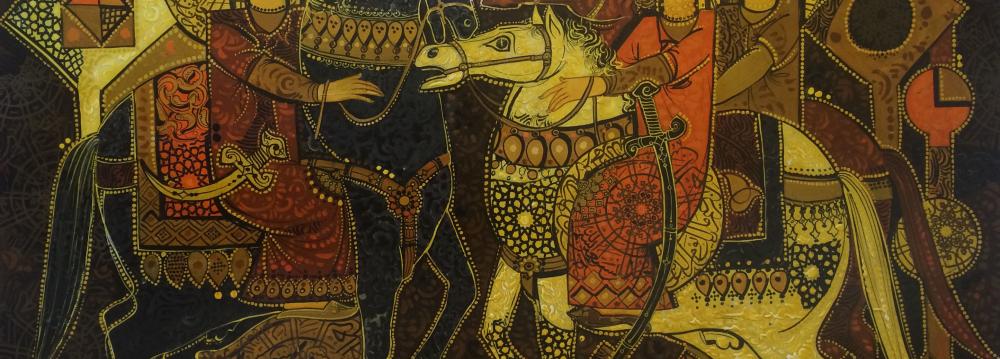Works of contemporary Iranian artists went on the walls of an exhibition on May 29 in Istanbul along with works of Turkish artists.
A press release by the Tehran-based Farda Art Gallery, the event organizer, says works by Iranian artists Sadeq Tabrizi (1939-2018) and Mansur Qandriz (1935-1965) alongside works by Turkish artists including Devrim Erbil, Baris Saribas, and Yasin Ozturk are on view at the 7 Art Gallery in Istanbul until June 14.
Works of three young Iranian artists, including Hamed Sadr-Arhami, Kaveh Kavousi and Hamid Tolouei, are also displayed alongside the works of masters, ISNA reported on its Persian website.
Sadeq Tabrizi
Sadeq Tabrizi, passed away in January at the age of 79 while he was in London for liver cancer treatment.
He was an influential figure in the formation of the Saqqakhaneh art movement, a neo-traditional style of art that derives inspiration from Iranian folk art and culture. He is one of the few contemporary artists who have made valuable contributions both to the creation and dissection of modern art in Iran.
He can be considered a holistic artist who, in giving dimension to his practice, bestowed new perspectives to Iranian contemporary art, the artist’s website Tabrizigalleries.com, wrote.
Prerequisites of such a holistic approach can be traced in Tabrizi’s adventurous spirit. Upon graduating from three years of high school in miniature painting, and after working in some ceramic workshops in 1959, Tabrizi chose to practice painting on pottery. This change of focus accorded him the opportunity to work with glaze and fire.
While working on wall inscriptions for a mosque, a tile worker made Tabrizi realize how beautiful inscriptions are, and encouraged him to make a composition of letters and words which were not necessarily meaningful. The result was a ceramic panel (70x70cm) with a new composition in white and azure, the usual colors of inscriptions used in adoring mosques.
The delightful experience encouraged the artist to employ the same technique in painting on jugs, bowls, and plates using ochre and brown colors on cream background, and azure and turquoise on white background.
This led to the emergence of calligraphy in Iranian contemporary art. It can be said that the trend known as “calligraphy-based painting,” which later emerged in the works of Saqqakhaneh painters and again in the work of calligraphers (from a different perspective and through calligraphy-based painting), originated from Tabrizi’s initiative.
Mansur Qandriz
While still in high school, Qandriz was attracted to the realist paintings of Russian artist Ilya Repin (1844–1930) and Russian-Armenian seascape artist Ivan Aivazovsky (1817–1900).
Qandriz was determined to create a certain Iranian modernism with roots in traditional and indigenous elements; but at the same time he followed the structure of western modern art. To achieve an original expression, Qandriz moved from pure abstraction to meaningful visual symbols. A mythological approach and old mysterious subjects gradually found their way into his works.
He usually emphasized a spiritual quality, based on aesthetic values of traditional Iranian illustration in his painting, thus avoiding pure formalism.
Flat and brightly colored surfaces as well as soft lines are distinct features of his works. Qandriz was one of the founders of the Saqqakhaneh movement.


